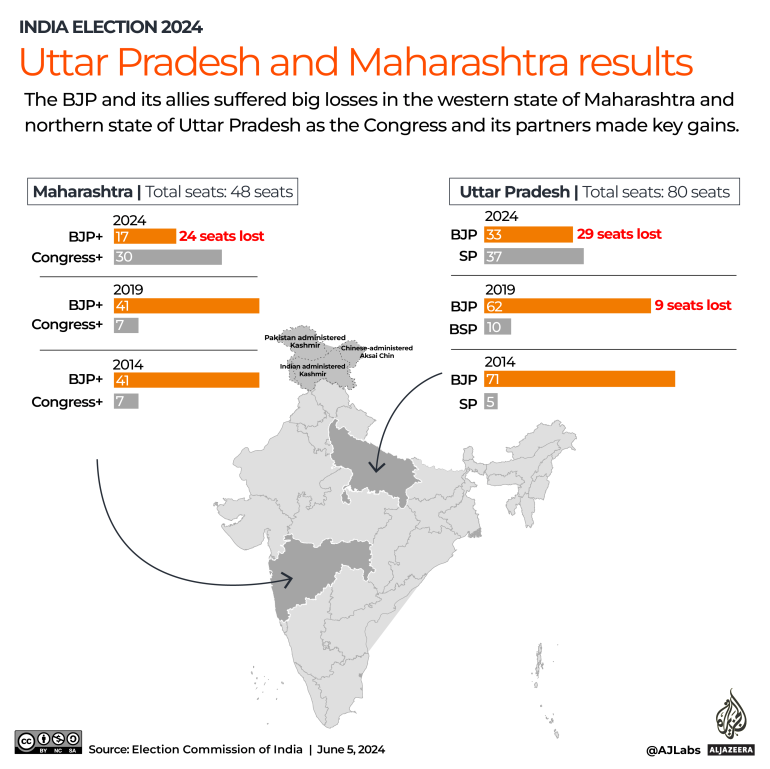Mumbai, India – As the results of India’s national elections became clear on Tuesday, Narendra Dabhane felt a sense of achievement and relief.
The farmer from Maharashtra’s Yavatmal district was once an ardent admirer of Prime Minister Narendra Modi, who had promised to address the struggles of farmers, including farm debt, in the state’s Vidarbha region. Modi had even visited Dabhane’s village of Dabhadi during his 2014 campaign to first become prime minister. The village was handpicked out of the 15,000 villages in the Vidarbha region for Modi’s outreach to farmers in 2014.
But after 10 years of Modi’s rule, those crises have deepened. So, in February, when Modi was visiting Yavatmal, Dabhane wanted to meet the prime minister to express his disappointment. The police, though, detained him and did not allow his protests. He was released after Modi left.
Yet, on Tuesday, when the results showed a dramatic fall in the BJP’s seat tally from Maharashtra, Dabhane felt vindicated. The party, which in 2019 had won 23 seats in the country’s second-most politically consequential state – Maharashtra sends 48 legislators to the lower house of India’s parliament, behind only Uttar Pradesh state – secured only nine seats this time around. Its National Democratic Alliance, which won 41 seats in 2019, got only 17 in 2024.
It is a pattern that appears to have played out across many key farm belts in India. Nationally, the BJP lost its majority after a decade of dominance, winning 240 seats in a house of 543, compared with 303 in 2019. Modi and his party are still expected to form India’s next government but will be dependent on alliance partners to keep it afloat.
An early analysis of the results suggests that millions of rural voters like Dabhane in some of the largest food-producing states of India dumped the BJP this time. In Haryana, known as India’s bread basket, where the BJP won 10 out of 10 seats on offer in 2019, its tally was slashed to five this time, with the opposition Congress winning the other five. The BJP drew a blank in Punjab, one of the top producers of rice and wheat in the country.
In Rajasthan, where the BJP won the state government only last December, it won 14 seats out of 25 – it had won all 25 in 2019. Amraram, a farmer leader from the Communist Party of India (Marxist), won against the BJP’s incumbent MP, banking on farm issues and anger among farmers towards the Modi government, in a seat where the left had never won before. And in Uttar Pradesh, where 65 percent of the population is dependent on agriculture, the BJP won just 33 seats out of 80, down from 62 in 2019 and 71 in 2014.
Nationally, the NDA witnessed a 2.2 percent drop in its vote share in rural areas, according to an analysis by The Hindu newspaper, a national daily in India. Meanwhile, the opposition Congress-led INDIA alliance’s rural and semi-rural area vote share rose by nearly 18 percent.
“If you see the results, it is clear that one of the major reasons for the BJP’s poor performance in rural areas is this anger among farmers towards Modi and the BJP,” said Punjab-based Devinder Sharma, an agricultural scientist and widely respected farm analyst.
Al Jazeera requested comments on the criticism of the party’s farm policies from the BJP’s national media chief, Anil Baluni, but did not receive a response.

What’s behind the farm anger?
Government data shows that from 2018 to 2022, as many as 53,478 farmers took their own lives, crushed by unending debt, poor remuneration for their produce and erratic weather patterns – all factors made only worse by the Modi government’s farm policies, experts said.
In the Vidarbha region, the crisis has only ballooned since Modi came to power. Under the previous Congress-led government, the region saw 9,671 farmers taking their own lives between 2004 and 2014, according to data shared by the Divisional Commissionerate of Amravati. Under Modi, suicides rose to 10,122 between January 2015 to December 2023.
When Modi first came to power in 2014, he had promised to reform the agriculture sector and double farm income. Farmers, though, continue to live in penury, with farmers earning an annual average of Rs 10,218 ($122), or a daily income of just Rs 28 ($0.34), government data from 2022 shows.
Modi’s government pushed through three controversial new laws to regulate Indian agriculture in 2020, without any consultations with farmers’ groups. The step triggered a massive yearlong protest by farmers, who feared that these laws would usher in greater corporatisation of Indian agriculture and would lead to the government scrapping state-backed protections for them, like a minimum support price and the procurement of farm produce by state agencies.
The government eventually rolled those laws back, but only after cracking down on protests by arresting farmers, barricading highways to stop them from coming to the capital New Delhi, firing shotguns and pellets, as well as using drones to drop tear gas on unarmed farmers.
Farmers took to the streets again in February to demand legal guarantees of a minimum support price (MSP) for crops among others. But talks with government officials remained inconclusive.

Experts like Sharma believe the protests galvanised the country’s farmers into political action.
In Punjab, for instance, farmers face issues like a drop in land productivity, along with rising costs eating into their profits. The recent protest movements gave farmers a platform to organise themselves politically and raise their concerns collectively, said Sharma.
“The farm laws spurred a fresh momentum among farmers of the country. There was anger in farmers about their state, but when the three laws were pushed through, the anger got channelised,” he said.
In states like Punjab and Haryana, furious farmers, angry with the BJP government for disallowing their protest march to Delhi, staged protests against BJP candidates when they came to campaign ahead of the election. Some villages barred BJP candidates from entering.
Incumbent MP and BJP leader Preneet Kaur, who fought – and lost – from the city of Patiala in Punjab, confessed that the state was seeing a “farmers vs BJP” contest.
It is not a phenomenon that was limited to Punjab.
Vaibhav Pandit from Maharashtra’s Vidarbha region, is a farmer and a lawyer who works with other young farmers in the Yavatmal district, known for its cotton production. But cotton prices have declined over the last year, and the state-mandated MSP, at 6,620 rupees ($79) for a quintal, is just not enough to make farming sustainable and should be raised to at least 10,000 rupees ($120), say farmers. To make it worse, the government has withdrawn a 10 percent duty it had imposed on imports of premium cotton into India, a move, farmers say led to a further drop in prices due to a glut in supply.
Pandit said all these issues shaped voting patterns in Vidarbha. “Even those younger farmers, who did not care about political ideologies, could see that while the rates for their produce were declining, the production costs were rising continuously,” he said.
Amid their own disappointments, the farmers’ protests in north India only fuelled their anger, thousands of kilometres away, in Vidarbha, said Pandit.
“At any given point, one in five WhatsApp status messages that young farmers around me uploaded were about the farmers’ protests and the need to support the case,” Pandit said.
For many farmers around him, Pandit says, the cause of the protesting farmers was not itself as important as the fury over how the government was treating these protesting cultivators.
In Vidarbha, traditionally a BJP bastion, the NDA alliance could only manage to win three of the total 10 seats.

Anger in the onion bowl
In Maharashtra’s onion belt, more than 500km (310 miles) to the West, farmers’ anger over the crashing of onion prices is also reflected in the results.
Candidates from Modi’s party, the BJP, and its allies were defeated in all but one onion-producing district.
Bharat Dighole, the chief of the Maharashtra State Onion Farmers’ Association, is not surprised.
For years now, onion cultivators have faced pitiably low prices. Last year, an onion farmer reportedly earned as little as 2.90 rupees ($0.03) as net profit for the sale of 512kg (1,130 pounds). Farmers blame government policies. For instance, just when prices for farmers had started inching up, in December last year, the Modi government banned onion exports, causing prices to crash. The ban resulted in a crash in onion prices, down to 22 rupees ($0.26) per kilogramme, which pushed farmers into deep losses.
Dighole said farmers were livid with the move, but their complaints went unheeded.
“The Modi government had an overwhelming majority, and hence, it thought it didn’t need to consult farmers before taking any steps around their livelihood,” he said.
When Modi came campaigning in this onion-growing belt, Dighole asked local officials for a two-minute meeting with the prime minister so he could brief the leader on how the ban was affecting local farmers.
“Instead, local officials placed me under home arrest the day Modi came to this area,” Dighole said, speaking from Nashik. “You have been ruling us for 10 years, but you don’t even have two minutes to spare for us? That is what many farmers started asking themselves when Modi did this,” Dighole said.
The Modi government lifted the onion export ban a day before the onion-producing belt went to polls, but it was too late. “The farmers were livid with the government, and hence, the opposition benefitted from this anger,” Dighole said.
Vijay Jawandhiya, a veteran farmer leader from Maharashtra, said the BJP paid a price for its policies.
“There has come to be a strong perception that the BJP government took the support of farmers for granted,” Jawandhiya said. “It almost felt like the BJP thought the farmers would never abandon the party,” he added.
Over the years, said Dighole, the onion farmers association head, farmers had ceased voting on agrarian issues. “A farmer also gets influenced by other non-farm identities he carries, be it his caste or religion. Hence, farmers were, for many years now, getting swayed to vote on caste and religious lines,” said Dighole.
That had changed in 2024, he said.
“This time, farmers prioritised their farm identity over everything else and voted as farmers first.”
Read More: World News | Entertainment News | Celeb News
Al Jazeera








